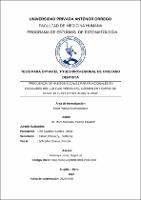Mostrar el registro sencillo del ítem
Frecuencia de hábitos bucales parafuncionales en escolares del colegio Virgen del Carmen en Tiempos de Covid - 19 El Porvenir Agosto - 2020
| dc.contributor.advisor | Huarcaya López, Jorge Luis | |
| dc.contributor.author | Mozo Marquina, Victoria Elizabeth | |
| dc.creator | Mozo Marquina, Victoria Elizabeth | |
| dc.date.accessioned | 2022-06-29T01:01:12Z | |
| dc.date.available | 2022-06-29T01:01:12Z | |
| dc.date.issued | 2022 | |
| dc.identifier.uri | https://hdl.handle.net/20.500.12759/9131 | |
| dc.description.abstract | Determinar la frecuencia de hábitos parafuncionales en escolares de 5 a 12 años de edad en tiempos de covid-19 El Porvenir. Agosto-2020 Materiales y método: El estudio fue observacional. Se evaluaron a 336 escolares de 5 a 12 años de edad de ambos géneros a quienes se les aplicó un cuestionario de 10 preguntas de manera virtual para determinar la frecuencia de hábitos parafuncionales. Resultados: El hábito parafuncional de mayor frecuencia fue el morder objetos como: juguetes o lapiceros (48% )y el que presentó menor frecuencia el uso de chupón con 1%, (p<0.05). Según el género, en mujeres se encontró mayor frecuencia en la pregunta el niño/a se chupa los dedos (7%), (p<0.05). Conclusiones: El hábito más frecuente fue el de morder objetos y el de menor frecuencia fue el uso de chupón en un 1%. Los hábitos fueron más frecuentes entre los 8 y los 9 años de edad. Según el género, el hábito más representativo fue succión digital en mujeres. | es_PE |
| dc.description.abstract | To determine the frequency of parafunctional habits in schoolchildren between 5 and 12 years of age in times of covid-19 El Porvenir. August-2020 Materials and method: A prospective, cross-sectional, descriptive, and observational study was carried out. 336 schoolchildren between the ages of 5 to 12 years of age of both genders were evaluated to whom a 10-question questionnaire was applied virtually to determine the frequency of parafunctional habits. Results: The parafunctional habit that presented the highest frequency was the one that mentions whether the child bites objects such as, for example: toys or pencils with 48% and the one that presented the least frequency was the one that mentions whether the child uses a pacifier with 1 %, (p <0.05). According to gender, in women, the child sucks his fingers (7%), (p <0.05). Conclusions: The most frequent habit in the population was that of biting objects, the less frequent was the one mentioned if the child used a pacifier with 1%. According to age, the habits were more frequent between 8 and 9 years of age and less frequent between 10 and 11 years of age. In the range of 5 to 6 years. According to gender, the most representative habits in women were found to be more frequent in the question the child sucks his fingers. | en_US |
| dc.description.uri | Tesis | es_PE |
| dc.format | application/pdf | es_PE |
| dc.language.iso | spa | es_PE |
| dc.publisher | Universidad Privada Antenor Orrego | es_PE |
| dc.relation.ispartofseries | T_ESTO_991 | |
| dc.rights | info:eu-repo/semantics/openAccess | es_PE |
| dc.rights.uri | https://creativecommons.org/licenses/by/4.0/ | es_PE |
| dc.source | Universidad Privada Antenor Orrego | es_PE |
| dc.source | Repositorio Institucional - UPAO | es_PE |
| dc.subject | Hábitos Parafuncioanles | es_PE |
| dc.subject | Escolares | es_PE |
| dc.title | Frecuencia de hábitos bucales parafuncionales en escolares del colegio Virgen del Carmen en Tiempos de Covid - 19 El Porvenir Agosto - 2020 | es_PE |
| dc.type | info:eu-repo/semantics/bachelorThesis | es_PE |
| thesis.degree.level | Título Profesional | es_PE |
| thesis.degree.grantor | Universidad Privada Antenor Orrego. Facultad de Medicina Humana | es_PE |
| thesis.degree.name | Cirujano Dentista | es_PE |
| thesis.degree.discipline | Estomatología | es_PE |
| dc.subject.ocde | https://purl.org/pe-repo/ocde/ford#3.02.14 | es_PE |
| renati.advisor.orcid | https://orcid.org/0000-0003-2136-3153 | es_PE |
| renati.author.dni | 48319731 | |
| renati.advisor.dni | 21546829 | |
| renati.type | https://purl.org/pe-repo/renati/type#tesis | es_PE |
| renati.level | https://purl.org/pe-repo/renati/level#tituloProfesional | es_PE |
| renati.discipline | 911016 | es_PE |
| renati.juror | Del Castillo Huertas, Oscar | |
| renati.juror | Zárate Chavarry, Stefanny | |
| renati.juror | Schreiber Cueva, Priscila | |
| dc.publisher.country | PE | es_PE |
Ficheros en el ítem
Este ítem aparece en la(s) siguiente(s) colección(es)
-
Estomatología [653]


